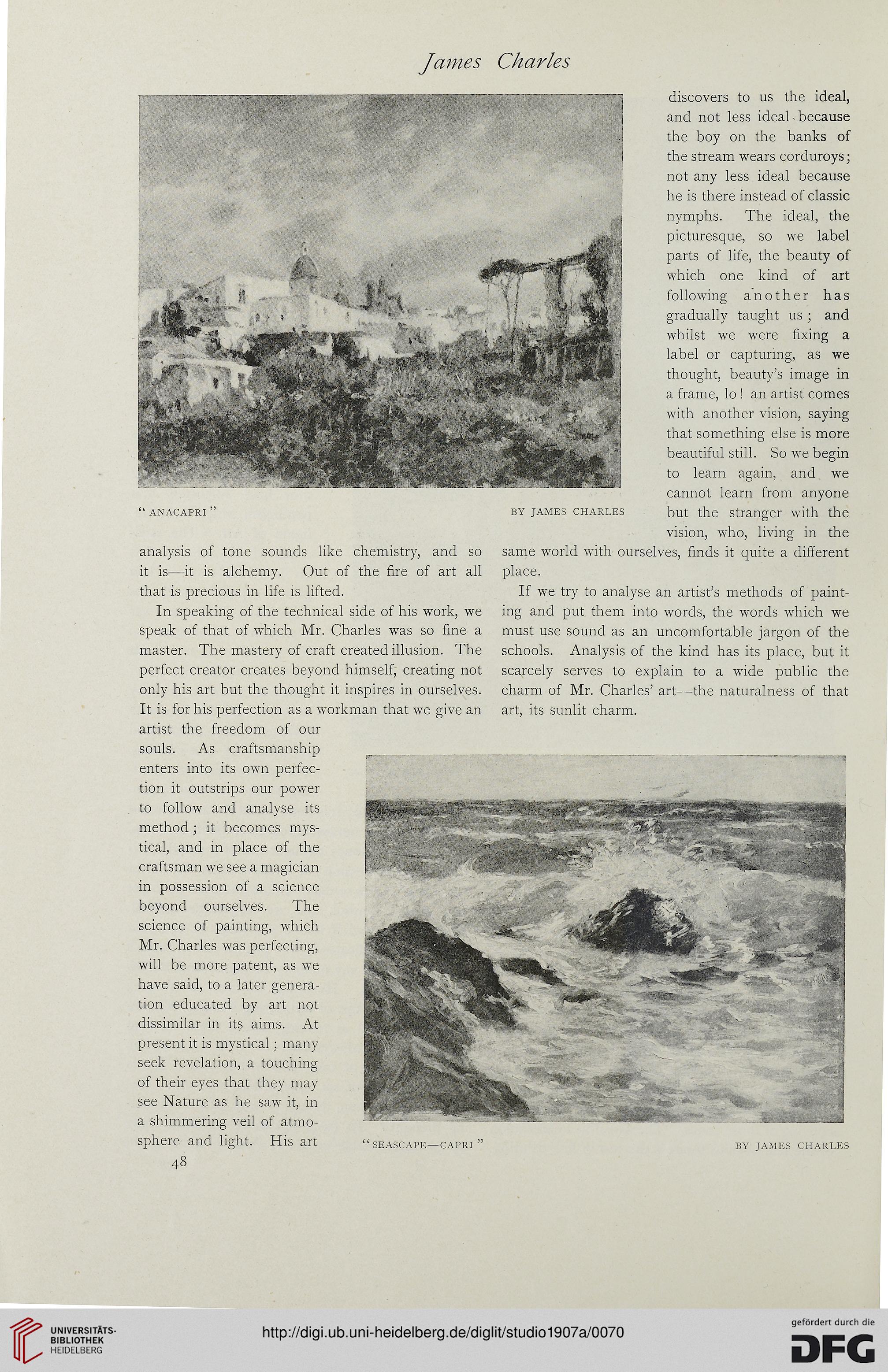James Charles
“ ANACAPRI ”
analysis of tone sounds like chemistry, and so
it is—it is alchemy. Out of the fire of art all
that is precious in life is lifted.
In speaking of the technical side of his work, we
speak of that of which Mr. Charles was so fine a
master. The mastery of craft created illusion. The
perfect creator creates beyond himself, creating not
only his art but the thought it inspires in ourselves.
It is for his perfection as a workman that we give an
artist the freedom of our
souls. As craftsmanship
enters into its own perfec-
tion it outstrips our power
to follow and analyse its
method; it becomes mys-
tical, and in place of the
craftsman we see a magician
in possession of a science
beyond ourselves. The
science of painting, which
Mr. Charles was perfecting,
will be more patent, as we
have said, to a later genera-
tion educated by art not
dissimilar in its aims. At
present it is mystical; many
seek revelation, a touching
of their eyes that they may
see Nature as he saw it, in
a shimmering veil of atmo-
sphere and light. His art “ seascape—capri ”
48
discovers to us the ideal,
and not less ideal-because
the boy on the banks of
the stream wears corduroys;
not any less ideal because
he is there instead of classic
nymphs. The ideal, the
picturesque, so we label
parts of life, the beauty of
which one kind of art
following another has
gradually taught us ; and
whilst we were fixing a
label or capturing, as we
thought, beauty’s image in
a frame, lo ! an artist comes
with another vision, saying
that something else is more
beautiful still. So we begin
to learn again, and we
cannot learn from anyone
by james Charles but the stranger with the
vision, who, living in the
same world with ourselves, finds it quite a different
place.
If we try to analyse an artist’s methods of paint-
ing and put them into words, the words which we
must use sound as an uncomfortable jargon of the
schools. Analysis of the kind has its place, but it
scarcely serves to explain to a wide public the
charm of Mr. Charles’ art—the naturalness of that
art, its sunlit charm.
BY JAMES CHARLES
“ ANACAPRI ”
analysis of tone sounds like chemistry, and so
it is—it is alchemy. Out of the fire of art all
that is precious in life is lifted.
In speaking of the technical side of his work, we
speak of that of which Mr. Charles was so fine a
master. The mastery of craft created illusion. The
perfect creator creates beyond himself, creating not
only his art but the thought it inspires in ourselves.
It is for his perfection as a workman that we give an
artist the freedom of our
souls. As craftsmanship
enters into its own perfec-
tion it outstrips our power
to follow and analyse its
method; it becomes mys-
tical, and in place of the
craftsman we see a magician
in possession of a science
beyond ourselves. The
science of painting, which
Mr. Charles was perfecting,
will be more patent, as we
have said, to a later genera-
tion educated by art not
dissimilar in its aims. At
present it is mystical; many
seek revelation, a touching
of their eyes that they may
see Nature as he saw it, in
a shimmering veil of atmo-
sphere and light. His art “ seascape—capri ”
48
discovers to us the ideal,
and not less ideal-because
the boy on the banks of
the stream wears corduroys;
not any less ideal because
he is there instead of classic
nymphs. The ideal, the
picturesque, so we label
parts of life, the beauty of
which one kind of art
following another has
gradually taught us ; and
whilst we were fixing a
label or capturing, as we
thought, beauty’s image in
a frame, lo ! an artist comes
with another vision, saying
that something else is more
beautiful still. So we begin
to learn again, and we
cannot learn from anyone
by james Charles but the stranger with the
vision, who, living in the
same world with ourselves, finds it quite a different
place.
If we try to analyse an artist’s methods of paint-
ing and put them into words, the words which we
must use sound as an uncomfortable jargon of the
schools. Analysis of the kind has its place, but it
scarcely serves to explain to a wide public the
charm of Mr. Charles’ art—the naturalness of that
art, its sunlit charm.
BY JAMES CHARLES




